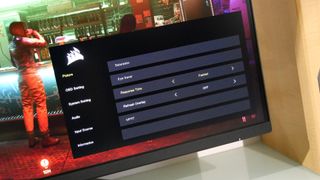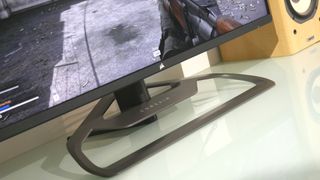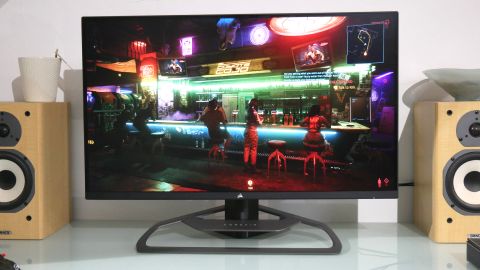Our Verdict
Corsair’s new 32-inch gaming panel is a great all-rounder. It’s quick, vibrant, well built, thoughtfully specified, and good for all types of gaming. But it’s also extremely expensive for a “mere” 1440p panel.
For
- Great all-round image quality
- Pretty quick and responsive
- Excellent build quality
Against
- “Only” 1440p
- Limited HDR support
- Seriously pricey
PC Gamer's got your back
Do you want a great all-rounder, something really polished and well executed. Or something more specialised with a wow factor but also a few flaws or missing features? The new Corsair Xeneon 32QHD165 falls firmly into the first category. On paper, it’s nothing special. 32 inches, IPS panel, 165Hz refresh, 1440p resolution, sub-3ms response, basic HDR capability, you get the idea.
It’s a nice combination of features, of course. You could say it pretty much nails the sweetspot for real-world gaming, what with 4K generating such crazy levels of GPU load and ultrawide monitors coming with their own set of limitations. At least, you could were it not for one small snag. The price. This thing clocks in at $799 (£699). That’s a heck of a lot of money for a plain old 1440p panel. It really is.
Panel size: 32-inch
Panel technology: IPS
Native resolution: 2560 x 1440
Aspect Ratio: 16:9
Refresh rate: 165Hz
Response time: 1ms MPRT
HDR: VESA DisplayHDR 400
Contrast: 1,000:1
Color: 98 percent DCI-P3
Brightness: 400 cd/m2
Inputs: DisplayPort 1.4 x1, HDMI 2.0 x2, USB Type-C with 15W charging
Other: AMD FreeSync Premium, G-Sync compatible
So, how does the Corsair Xeneon 32QHD165 justify that pricing? For starters, there’s the engineering and broader attention to detail. The cast aluminum stand (which adjusts for height, tilt, and swivel) is a definite cut above the norm for build quality. There’s attention to detail in the OSD menu, too, which is clearer and more logical than the norm. In other words, there are unusually high levels of polish and refinement wherever you look.
As for the detailed specifications, it’s mostly good news but likewise debatable whether it all adds up to enough to compensate for that price tag. The 2,560 by 1,440 pixel native resolution combined with the 32-inch 16:9 aspect panel proportions translate into sub-100DPI pixel density. That’s not necessarily a major problem in-game. But it does make for chunky pixels in a broader computing context. And again, at this price point, you might demand a screen with all-around precision, not just pure gaming nous.
Speed-wise, the 165Hz refresh is complimented by 1ms MPRT and sub-3ms gray-to-gray pixel response. Decent numbers, to be sure. But the quickest 1440p IPS panels now clock in at 240Hz and 1ms gray-to-gray. So, it’s hard to argue that’s where your money is going.
The same applies to HDR performance. The Corsair Xeneon 32QHD165 has VESA DisplayHDR 400 certification and a peak brightness of 400 nits. Inevitably, there is no local dimming and this is not a true HDR display. Static contrast, meanwhile, is pegged at the usual 1,000-to-one for an IPS panel.






One area that is slightly superior to the norm is color accuracy. Corsair claims 98 percent coverage of the DCI-P3 color space, which is more akin to a pro content creation panel than a gaming monitor and probably reflects the use of quantum dot technology in the Xeneon’s backlight.
Another arguable advantage over the masses involves inputs. The two HDMI 2.0 sockets and the DisplayPort 1.4 interface are predictable enough. But the USB Type-C with power delivery for single cable connection with charging to a laptop is a nice extra. Or, at least, it would be if the charging power wasn’t limited to a mere 15W, which is barely enough for something like a MacBook Air, let alone a gaming laptop.
It’s also worth noting that the HDMI ports are limited to 144Hz. But then they’re really there for hooking up to non-PC devices like consoles, to which end the Xeneon has a special “console mode” which involves accepting a 4K input and downscaling to 1440p. It’s obviously designed for the Sony PS5, which doesn’t do 1440p. But the basic idea of forcing a console to bear a heavy 4K rendering load only to downscale to 1440p doesn’t make much sense.

Anywho, taken in the round it’s hard to see anything in the speeds and feeds that really accounts for the Corsair Xeneon 32QHD165’s hefty price. So, what about the actual viewing and gaming experience? The core image quality is certainly good. It‘s punchy, vibrant, and well-calibrated. It’s quick, too, and very much feels good for the claimed specifications. Granted, a tiny bit of overshoot is visible in the fastest of the available pixel overdrive modes. And it’s not quite as sharp and blur-free as the very quickest 1ms GtG panels available right now.
Overall, it’s the kind of monitor that does a great job with every genre of game. For shooters like Apex Legends, there’s plenty of speed and no discernible latency. Graphics-heavy single-player adventures like CyberPunk 2077 look decent at 1440p, even if you’re obviously not going to get the insane detail that comes with 4K. The same goes for playing Total War-style strategy titles. 1440p is enough to stop various in-game menus and panels from eating up too much of the available screen real estate.
On the other hand, the Corsair Xeneon 32QHD165 doesn’t truly excel at anything. Esports addicts will want something even faster. Gamers with deep pockets looking for a really dramatic visual experience will likely also prefer either a 4K panel and the crazy detail and precision that brings or an ultrawide option for the ultimate in immersion.

If the Corsair Xeneon 32QHD165 was a bit cheaper, the fact that it was a creditable jack of all trades rather than being really outstanding in any area would be easier to accept. Ditto the fact that the fat pixel pitch isn’t a great fit for general computing duties, not if you like decent pixel density. For 800 bucks, that’s a little hard to swallow. It’s particularly conspicuous that the LG UltraGear 32GP850-B delivers the same panel size and resolution with slightly higher refresh and superior response for far less money, even if it can’t match the overall quality and vibrancy of the Corsair’s image quality.
So, yeah, the Corsair Xeneon 32QHD165 is a very good all-around gaming monitor. It’s polished, well-executed, and a great all-rounder. It’s just comfortably 30 percent overpriced to be really compelling.
Corsair’s new 32-inch gaming panel is a great all-rounder. It’s quick, vibrant, well built, thoughtfully specified, and good for all types of gaming. But it’s also extremely expensive for a “mere” 1440p panel.

Jeremy has been writing about technology and PCs since the 90nm Netburst era (Google it!) and enjoys nothing more than a serious dissertation on the finer points of monitor input lag and overshoot followed by a forensic examination of advanced lithography. Or maybe he just likes machines that go “ping!” He also has a thing for tennis and cars.
